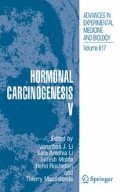Summary
Early full-term pregnancy reduces the risk of mammary cancer in humans. Rats and mice also exhibit this phenomenon of parity protection. Short-term treatment with pregnancy levels of estradiol (E2) is also highly effective in preventing mammary carcinogenesis. Earlier it has been demonstrated that parous rats treated with carcinogen develop latent microscopic mammary tumors that do not progress further to form overt mammary cancers. In the current investigation, we wanted to find out if short-term treatment with pregnancy levels of E2 also prevents mammary carcinogenesis similar to parity. Rats were injected with N-methyl-N-nitrosourea at 7 weeks of age and treated with 20μg, 100μg, 200μg, or 30 mg of E2 in silastic capsules for 3 weeks. 100μg (17%), 200μg (17%), and 30mg (17%) doses of E2 resulted in levels of E2 equivalent to pregnancy level and were effective in preventing overt mammary cancer incidence compared with control (100%) or 20μg (73%) E2 treatment, which did not result in pregnancy levels of E2 in the circulation. Although a significant reduction of overt cancers was observed in the pregnancy levels of E2 treated groups, there was no difference in the incidence of latent microscopic mammary cancers between the E2 treated and the controls. Proliferation of latent microscopic mammary cancers was examined using immunohistochemistry for cyclin D1 expression. Proliferation in the latent microscopic mammary cancers of the protected groups was significantly lower (∼2.0–3.0-fold) than the latent microscopic mammary cancers in the unprotected groups. These findings indicate that mammary cancer development can be blocked by inhibiting or blocking promotion and progression of carcinogen initiated cells.
Access this chapter
Tax calculation will be finalised at checkout
Purchases are for personal use only
Preview
Unable to display preview. Download preview PDF.
References
MacMahon B, Cole P Lin TM, et al. (1970) Age at first birth and breast cancer risk. Bull WHO 43:209–221.
Moon RC (1969) Relationship between previous reproductive history and chemically induced mammary cancer in rats. Int J Cancer 4:312–317.
Marchant J (1955) Influence of pregnancy and lactation on the incidence of mammary carcinoma induced with methylcholanthrene in female mice of the IF strain. J Pathol Bacteriol 70:415–418.
Huggins C, Moon RC, Morii S (1962) Extinction of experimental mammary cancer. I. Estradiol-17beta and progesterone. Proc Natl Acad Sci USA 48:379–386.
Grubbs CJ Juliana MM, Whitaker LM (1988) Short-term hormone treatment as a chemopreventive method against mammary cancer initiation in rats. Anticancer Res 8:113–117.
Russo IH, Koszalka M, Russo J (1990) Effect of human chorionic gonadotropin on mammary gland differentiation and carcinogenesis. Carcinogenesis 11:1849–1855.
Guzman RC, Yang J, Rajkumar L, et al. (1999) Hormonal prevention of breast cancer: mimicking the protective effect of pregnancy. Proc of the Natl Acad Sci USA 96:2520–2525.
Rajkumar L, Guzman RC, Yang J, et al. (2001) Short-term exposure to pregnancy levels of estrogen prevents mammary carcinogenesis, Proc Natl Acad Sci USA 98:11755–11759.
Yang J, Yoshizawa K, Nandi S, et al. (1999) Protective effects of pregnancy and lactation against N-methyl-N-nitrosourea-induced mammary carcinomas in female Lewis rats. Carcinogenesis 20:623–628.
McMahon C, Suthigphongchai T, DiRenso J, et al. (1999) P/CAF associates with cyclin D1 and potentiates it s activation of the estrogen receptor. Proc Natl Acad Sci USA 96:5382–5387.
Korkola J, Wood G, Archer M (1999) Cyclin D1 expression during rat mammary tumor development and its potential role in the resistance of the Copenhagen rat. Breast Cancer Res 1:88–94.
Yatani R, Shiraishi T, Nakakuki K, et al. (1998) Trends in frequency of latent prostate carcinoma in Japan from 1965–1979 to 1982–1986. J Natl Cancer Inst 80:683–687.
Author information
Authors and Affiliations
Editor information
Editors and Affiliations
Rights and permissions
Copyright information
© 2008 Springer
About this chapter
Cite this chapter
Lakshmanaswamy, R., Guzman, R.C., Nandi, S. (2008). Hormonal Prevention of Breast Cancer: Significance of Promotional Environment. In: Li, J.J., Li, S.A., Mohla, S., Rochefort, H., Maudelonde, T. (eds) Hormonal Carcinogenesis V. Advances in Experimental Medicine and Biology, vol 617. Springer, New York, NY. https://doi.org/10.1007/978-0-387-69080-3_46
Download citation
DOI: https://doi.org/10.1007/978-0-387-69080-3_46
Publisher Name: Springer, New York, NY
Print ISBN: 978-0-387-69078-0
Online ISBN: 978-0-387-69080-3
eBook Packages: Biomedical and Life SciencesBiomedical and Life Sciences (R0)

